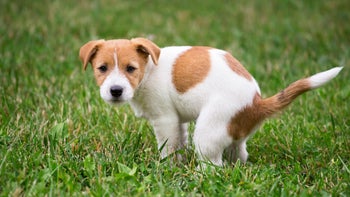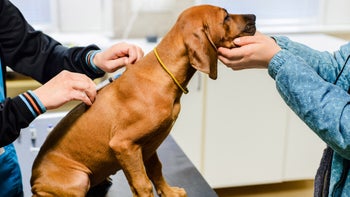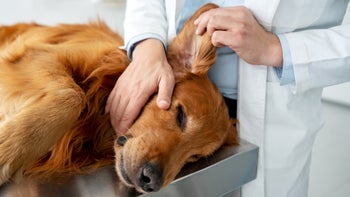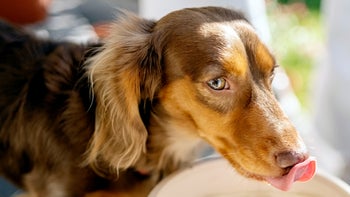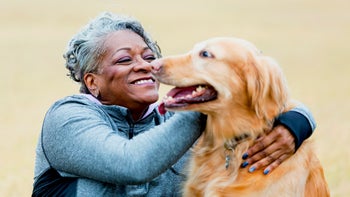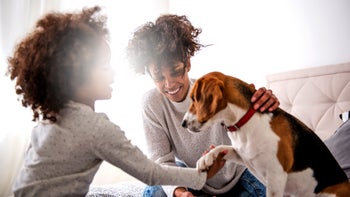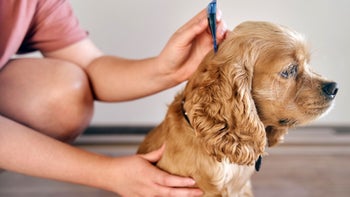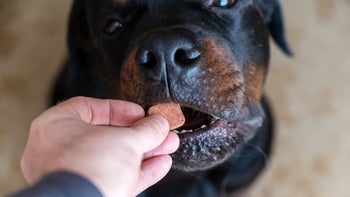
Dog Drooling: How to Know if It’s Harmless vs. a Reason to Worry
Key takeaways:
With dogs, a certain amount of drooling is normal, especially for floppy lipped breeds or dogs that are around something tasty.
Excessive drooling, on the other hand, can indicate an underlying problem such as dental disease, nausea, anxiety, or a more serious condition.
If your dog’s drooling is sudden, extreme, or accompanied by other symptoms, take them to see the veterinarian.

Drooling is a common condition in dog breeds known for their slobbery tendencies. But while a certain amount of drooling is completely normal, excessive or sudden drooling can be a sign that something’s off.
From dental issues to anxiety, there are many reasons why your dog might be drooling more than usual. Understanding when drooling is harmless versus when it’s a problem is key to keeping your dog healthy. With the help of some experts, we’ll break down the most common causes of drooling in dogs, when to seek veterinary care, and what you can do to help.
Why is your dog drooling so much?
Drooling is normal for many dogs, so it’s not always a cause for concern. Here are common reasons that dogs drool.
Search and compare options
Food smells
Dogs have a strong sense of smell that can lead to salivation. For example, it’s not unusual to see a dog drooling when they smell something delicious, like a steak on the kitchen counter or a handful of their favorite treats.
Sleep position
Some dogs sleep on their side or with their head angled downward. This can cause more drooling, especially in dogs with loose jowls. But Kathryn Dench, DVM, warns that drooling combined with unusual sleeping patterns or signs of distress means it’s time to consult a veterinarian.
Dental issues
Dental issues, such as gum disease, tartar buildup, or abscessed teeth, can lead to excessive saliva. A dog might also drool more than usual if they have something stuck in their gums or teeth, like wood splinters from a stick.
Stress or anxiety
According to Turnera Croom, DVM, excessive drooling can also stem from psychological issues. “Drooling can sometimes come from stress or anxiety,” Croom said. “Dogs who are anxious may pant heavily, which can lead to drooling as a secondary symptom.”
Nausea and motion sickness
If your dog is nauseous, whether it’s from motion sickness or something they ate, they may drool more than normal. Check to see if your dog took a bite out of a toxic plant or got into other potential toxins. This can easily lead to stomach upset and drooling.
Heat exhaustion or heatstroke
If your dog is drooling a lot in hot weather, check to see if they’re experiencing heat-related distress. Heat exhaustion and heatstroke can lead to excessive panting and drooling in dogs. They are also medical emergencies that require immediate veterinary attention.
Is expensive dog food worth it? Read why some dog owners pay for special diets for their canine companions.
Slobbery kisses: Dog licks are often signs of love and affection. But in some cases, excessive licking can signal an underlying medical condition.
Relieving your pup’s pain: Here’s a complete guide to pain medications for dogs, including what’s safe and what’s not.
Other health conditions
More serious health concerns, like seizures, rabies, and megaesophagus, can also lead to an increase in drooling. If you notice your dog acting differently or their drooling is accompanied by other symptoms, take them to see the veterinarian.
What breeds are most likely to drool?
Breeds with loose jowls are natural droolers. “Their facial structure facilitates a greater accumulation of saliva, which naturally escapes from the sides of their mouths,” Dench explained. Breeds that are more prone to drooling include:
Saint Bernards
Newfoundlands
Bloodhounds
Mastiffs
Bulldogs
Basset hounds
Great Danes
Rottweilers
Bernese mountain dogs
Read more like this
Explore these related articles, suggested for readers like you.
Croom points out the importance of keeping dogs that belong to these breeds on a well-balanced diet that provides enough water to replenish what they lose in saliva. She also suggests adding chilled fruits and vegetables to their meals during warmer months.
What other symptoms should you watch for if your dog is drooling a lot?
When drooling becomes excessive or uncharacteristic, these symptoms may indicate there’s an underlying issue:
Bad breath
Pawing at the mouth
Lethargy
Swelling in the face or muzzle
Restlessness or pacing
Whining or other signs of pain
Shaking or shivering
“These signs help differentiate a benign cause from more urgent conditions like GI [gastrointestinal] blockages, bloat, or systemic infections, which require immediate veterinary attention,” Dench said.
How can you help a dog who’s drooling?
How to help your dog will depend on the cause of their drooling. Here are some tips to keep in mind:
If your dog belongs to a drooly breed, carry a rag to wipe their mouth.
If your dog is anxious, create a calming environment at home. Provide them with a quiet space to hang out, play soothing music, or use pheromone diffusers to promote relaxation.
Clean your dog’s mouth regularly and take them to the veterinarian for regular dental checkups.
Keep an eye on your dog when they chew on a bone or toy to make sure they don’t ingest anything harmful or hurt their mouth.
If your dog is consistently drooling more than usual, consult your vet.
When should you take a drooling dog to the vet?
While some drooling is normal, especially in certain breeds, it’s important to recognize when it may be a sign of a serious problem. If your dog’s drooling is sudden, persistent, without an obvious cause, or accompanied by other symptoms, talk to your veterinarian.
“If your dog is drooling and is vomiting, has swelling or changes in behavior, or there’s any suspected exposure to toxins, it’s crucial to visit a veterinarian immediately,” Croom said.
Dench also recommends getting your dog checked if they seem out of sorts or not themselves. “Early intervention can prevent more severe complications and ensure better outcomes,” she said.
The bottom line
Drooling in dogs is normal, especially for floppy-lipped breeds like bloodhounds and Saint Bernards. But it can also signal a serious health problem. If your dog is drooling a lot and has other symptoms, such as stinky breath or loss of appetite, they may need to see a veterinarian.
If your dog’s dribbles seem normal, on the other hand, there are a few things you can try to manage their drool. Carrying a rag to wipe your dog’s mouth, taking your dog to the vet for regular dental care, and providing a stress-free environment at home are all good places to start.
Why trust our experts?



References
American Animal Hospital Association. (2019). What common household items are toxic to pets?
Brooks, W. (2023). Megaesophagus in dogs. Veterinary Partner.
Brooks, W. (2024). Rabies in animals. Veterinary Partner.
Cohen, A. (n.d.). Heatstroke: A medical emergency. Cornell University College of Veterinary Medicine.
Kokocińska-Kusiak, A., et al. (2021). Canine olfaction: Physiology, behavior, and possibilities for practical applications. Animals.
Seksel, K., et al. (2014). Stress and anxiety - How do they impact the pet? The World Small Animal Veterinary Association.
Texas A&M University School of Veterinary Medicine. (2022). When to see a veterinarian for a dog’s stomach ache.
Texas A&M University School of Veterinary Medicine. (2024). Helping your pet with separation anxiety.
Texas A&M University School of Veterinary Medicine. (2024). Understanding the complexity of seizures.







